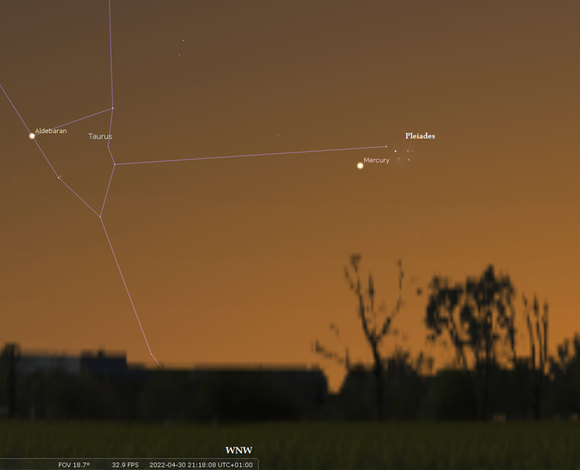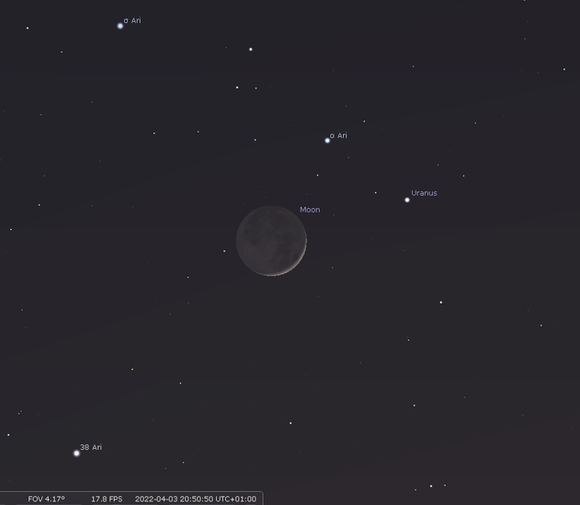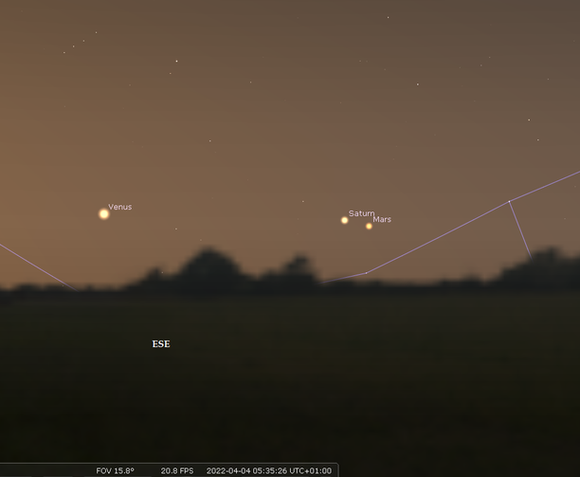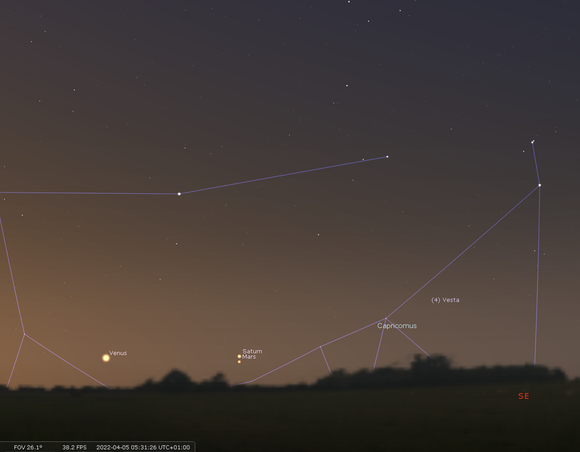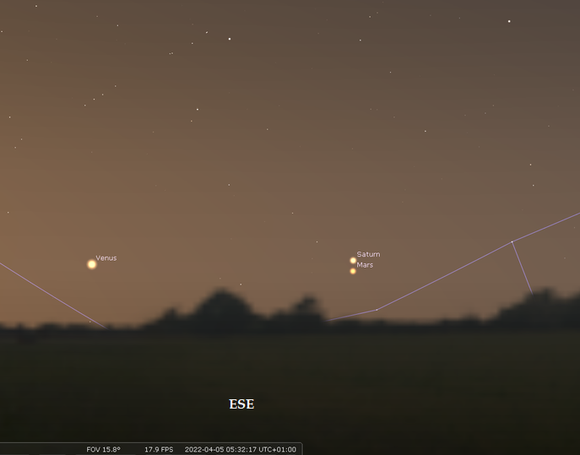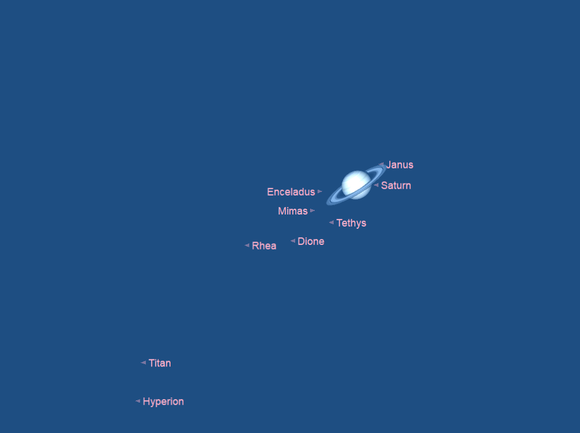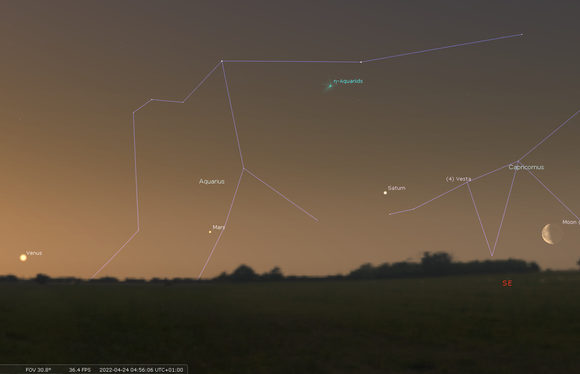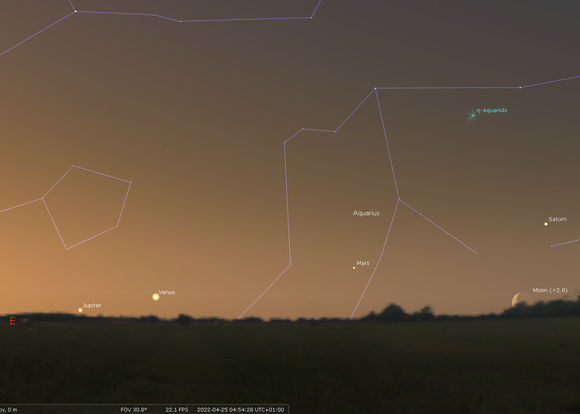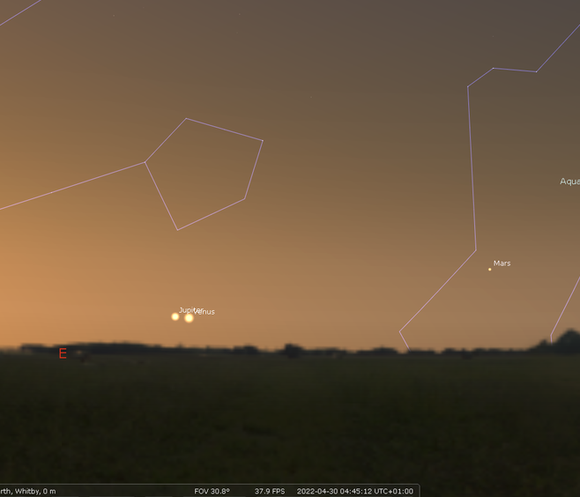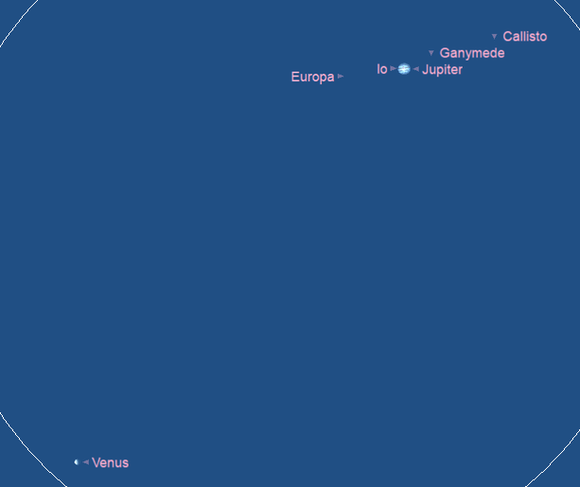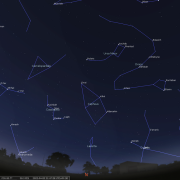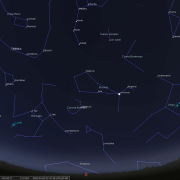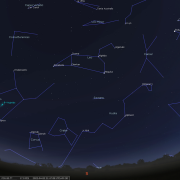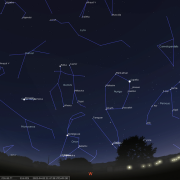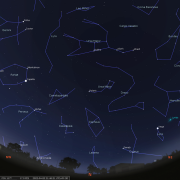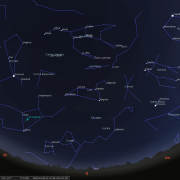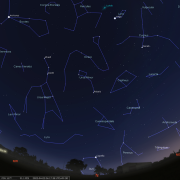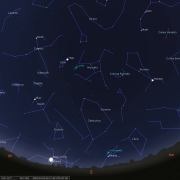In this month's Sky Notes:
Planetary Skylights - Brief
After a relatively quiet March for planetary interest, April offers up rather more to entice you outdoors with Mercury having its best evening apparition of the year mid month onwards. The real planetary highlights are reserved for the observer unfriendly hours of the dawn sky, the month bookended by two spectacular planetary conjunctions involving all the visible planets residing there.
 Elusive Mercury makes a return to the evening sky by mid April, having its best evening apparition of 2022. The innermost world will become visible by the 14th very low in the WNW, so you will require an observing site with unobstructed views of the NW horizon to have the best chance of tracking Mercury down. Wait until 35-45 minutes after sunset before doing so. At magnitude -1.3, Mercury will appear brightest at the start of its apparition and should be readily visible to the naked eye, however, do bear in mind the low altitude; ranging from just 4 degrees mid-month, reaching a positively heady 12 degrees (almost) by the month's end, before dropping back again. Take into account the fairly bright twilight and unstable atmospheric conditions at low elevations, which will tend to reduce its naked eye prominence. Mercury will gradually diminish in brightness the longer its apparition lasts, so there is always a trade off in choosing the optimum dates for spotting Mercury. Try viewing from the 18th - 26th around 20:35 - 20:50hrs BST.
Elusive Mercury makes a return to the evening sky by mid April, having its best evening apparition of 2022. The innermost world will become visible by the 14th very low in the WNW, so you will require an observing site with unobstructed views of the NW horizon to have the best chance of tracking Mercury down. Wait until 35-45 minutes after sunset before doing so. At magnitude -1.3, Mercury will appear brightest at the start of its apparition and should be readily visible to the naked eye, however, do bear in mind the low altitude; ranging from just 4 degrees mid-month, reaching a positively heady 12 degrees (almost) by the month's end, before dropping back again. Take into account the fairly bright twilight and unstable atmospheric conditions at low elevations, which will tend to reduce its naked eye prominence. Mercury will gradually diminish in brightness the longer its apparition lasts, so there is always a trade off in choosing the optimum dates for spotting Mercury. Try viewing from the 18th - 26th around 20:35 - 20:50hrs BST.
Given clear skies for the duration of Mercury's apparition, note the gradual gain in altitude as it arcs upwards from the horizon, before finally sliding away again in May. Also note how Mercury converges with the lovely Pleiades star cluster over the final week of April, passing the Seven Sisters at close quarters on the 30th. You will need to view around 21:10hrs BST.
Through a telescope Mercury is not much to look at, a phase may be discerned, which resembles a first quarter moon, but it is a small world never straying far from the Suns immediate vicinity and observations are usually hampered by unstable air present at low levels. Imaging can yield half satisfactory results, but nothing spectacular. Snap shots against a scenic background are perhaps the most pleasing. So wait until a fine evening presents itself during the latter part of April and go and bag the elusive messenger.
 Uranus will be visible with 'augmented eyes' (binoculars or Telescope) for the first week to ten days in April, thereafter it drops below the horizon before darkness falls. If you want to spot Uranus before departing an opportunity arises on April 3rd when a slim crescent moon lies just lower left. View over in the WSW around 20:45 BST. The Moon and Uranus will lie in the southern reaches of Aries, to the left of the crooked line asterism of stars marking the 'Ram' itself. Use binoculars first, Uranus will resemble a pale apple white 'star'. A 100mm scope will reveal this as a tiny disk.
Uranus will be visible with 'augmented eyes' (binoculars or Telescope) for the first week to ten days in April, thereafter it drops below the horizon before darkness falls. If you want to spot Uranus before departing an opportunity arises on April 3rd when a slim crescent moon lies just lower left. View over in the WSW around 20:45 BST. The Moon and Uranus will lie in the southern reaches of Aries, to the left of the crooked line asterism of stars marking the 'Ram' itself. Use binoculars first, Uranus will resemble a pale apple white 'star'. A 100mm scope will reveal this as a tiny disk.
Naked eye view of crescent Moon in proximity to Uranus -April 3rd @ 20:30hrs BST
(click for full image)
Binocular view of crescent Moon in proximity to Uranus -April 3rd @ 20:50hrs BST
(click for full image)
Dawn Planets

 The April dawn sky is home to quite a gathering of planets visible in the east, with Jupiter joining the party by mid-month. The down side is the awkward time - you will need to be observing around 5:30am at the start of the month and at least 45 minutes earlier by the end. The brilliant 'morning star'- Venus, acts as the anchor point on which to direct your gaze across in the SE, but, initially it will not be the focus of interest. This falls to the close planetary conjunction of Mars and Saturn which occurs during the first week of April. Look for two ’stars’ to the right of Venus. At mag +0.8 Saturn will be the slightly brighter one and will edge away from ESE horizon over the first few mornings of April, residing to the left of Mars on the 4th and directly above it on the 5th when they are just 19 arc minutes apart. Mars will be a few tenths fainter than Saturn and appear amber in hue. View at 05:30am BST when they will be approximately 7 degrees above the ESE horizon. Binoculars will pick them out nicely, however a telescope is required to reveal the rings of Saturn. A short focal length scope (f5 or f6) with low magnification will show them in the same field of view. You won't have much time and admittedly the image will be rather turbulent, but beggars can't be choosers. Mars will appear as a small orange dot - It's time will come at the end of the year when at opposition once again.
The April dawn sky is home to quite a gathering of planets visible in the east, with Jupiter joining the party by mid-month. The down side is the awkward time - you will need to be observing around 5:30am at the start of the month and at least 45 minutes earlier by the end. The brilliant 'morning star'- Venus, acts as the anchor point on which to direct your gaze across in the SE, but, initially it will not be the focus of interest. This falls to the close planetary conjunction of Mars and Saturn which occurs during the first week of April. Look for two ’stars’ to the right of Venus. At mag +0.8 Saturn will be the slightly brighter one and will edge away from ESE horizon over the first few mornings of April, residing to the left of Mars on the 4th and directly above it on the 5th when they are just 19 arc minutes apart. Mars will be a few tenths fainter than Saturn and appear amber in hue. View at 05:30am BST when they will be approximately 7 degrees above the ESE horizon. Binoculars will pick them out nicely, however a telescope is required to reveal the rings of Saturn. A short focal length scope (f5 or f6) with low magnification will show them in the same field of view. You won't have much time and admittedly the image will be rather turbulent, but beggars can't be choosers. Mars will appear as a small orange dot - It's time will come at the end of the year when at opposition once again.

 By mid-April Saturn has pulled well ahead of Mars which is drifting easterly. Venus lies further to the east. All remain in proximity to the horizon. As we head into the last week of April, there is much to interest the observer. First up; Jupiter returns to the sky, edging slowly away from the glare of the Sun after being in solar conjunction. Then on the 24th and 25th a slim waning crescent Moon settles down onto the SE horizon, with the chain of planets extending eastwards.
By mid-April Saturn has pulled well ahead of Mars which is drifting easterly. Venus lies further to the east. All remain in proximity to the horizon. As we head into the last week of April, there is much to interest the observer. First up; Jupiter returns to the sky, edging slowly away from the glare of the Sun after being in solar conjunction. Then on the 24th and 25th a slim waning crescent Moon settles down onto the SE horizon, with the chain of planets extending eastwards.
Venus and Jupiter then become the focus of attention right at the end of the month, when they are involved in a spectacular conjunction, the two brightest planets drawing together in the dying days of April and into May. They are actually closest on May 1st just 21 arc minutes apart. Given that the e-notes will not be circulated until noon of that day, chart views of the conjunction on May 1st are included in this month's notes. At magnitude -4.1 Venus will be the brightest of the pair with Jupiter, at magnitude -2.1 moving up from the E horizon and above Venus. They will only be around 8 degrees in altitude, so a good sight line is essential with regard to observation. Again, binoculars will give pleasing views of the two planets closing, but wide field scopes at low magnification will reveal more detail with both planets still framed in the same field of view. Be warned; the image will be compromised by the low altitude of Jupiter and Venus and detail will be fleeting. View no later than 04:50hrs BST over the days involved.
Meteor Watch - Lyrids

Regarded as the oldest observed meteor shower with recorded sightings dating back 2,700 years, the Lyrids (April 16-25th) peak over the night of the 22nd/23rd this year. The shower occurs when Earth passes through fine debris left over from Comet Thatcher (C/186 G1), which makes a full orbit of the Sun once every 415 years. Ideal hourly rates can exceed 25, however actual observed rates will be substantially lower, perhaps 10 or so. The radiant resides upper right of the bright star Vega in Lyra visible high to the east during the early morning hours. View at least a couple of hands spans away from Lyra. The early morning hours of the 23rd will yield best results; perhaps from 1-3am, but a few may be spotted pre-midnight. Light from a last Qtr Moon will interfere a little post 4am. Lyrids can produce bright fireballs – so it’s worth keeping an eye out over the entire period.
There will also be a few Virginid meteors early in the month, however levels are barely more than sporadic - 3 or 4 per hour. Various radiants exist, but the one in April is reported to lie close to Gamma Virginis. Meteors belonging to this shower are normally slow, of long duration and can produce flared trails. Occasionally there are sporadic outbursts, with several tens per hour. The peak date may be April 12th. Moonlight will interfere.
April Night Sky
Following the recent Jamaican Spring, normal service was resumed following the introduction of British Snow Time, or BST as we like to call it. As we all know just because the calendar tells us it's spring, whether it actually feels like spring is a different kettle of fish! Certainly evenings are markedly lighter and the stellar night sky appears quite different to that of the winter one as dusk falls. By then the seasonal ‘winter’ patterns we've grown accustomed to, are, or will, shortly be departing, slipping over the western horizon. Taurus heads the winter cavalcade, its chief star; fiery Aldebaran - ‘the eye of the bull’ in the arrow shaped Hyades star cluster, pointing the way. Following the Bull, mighty Orion’s march across our skies is reaching its conclusion, the hunter’s brightest star, blue-white Rigel first to set, followed by the three belt stars strung out in parallel above western horizon, then finally the ‘ruddy’ hue of Betelgeuse.
The brightest star in the night sky, Sirius- the ‘dog star’ in Canes Major sparkles just above the SSW horizon, catching the eye - and the unwary, who sometimes mistake it for a UFO (yes, worrying isn’t it) Rest assured its alarming scintillation is purely down to our turbulent atmosphere. Somewhat higher in the SSW, look for solitary Procyon, chief star in the lesser dog of Canis Minor. Higher still in the west, the twins of Gemini descend feet first above Taurus, their heads marked by the stars; Castor and Pollux respectively. Of all the bright winter stars visible, only Capella in Auriga the charioteer, found high in the NW will remain, spending late spring and summer low to the north horizon.
By the time astronomical twilight commences, the remainder of the sky to the south and east can at first sight appear rather sparse when compared to the majestic winter canopy fast disappearing into afterglow. Like some great musical overture in which there are sometimes quieter interludes, so the spring sky could be construed as one of these. That is not to say there is nothing of interest to observe, far from it. There are actually more deep sky objects accessible in telescopes than in the winter sky, though perhaps not the variety, with many galaxies visible as fuzzy blobs.
Considered spring’s signature constellation, Leo is one of the most important constellations in the entire sky. The lion stands guarding his territory to the south, its head and mane marked by a distinctive stellar asterism known as the ‘sickle’ – the gardening implement which resembles a backwards question mark. At the base of this arrangement shines Leo’s chief star, Regulus, faintest of the 1st magnitude stars visible in the night sky. Regulus sits almost on the ecliptic and as a consequence is sometimes joined in close proximity by the moon and planets and on rare occasions, occulted by them. In antiquity; from 4000 to 2000 BC Regulus was counted as one of the four Royal stars, those bright stars nearest the position of the equinox’s and solstices. During this period Regulus was closest to the summer solstice position, but over the millennia the effects of precession have moved this position away. The hindquarters of Leo are marked by a trianglular arrangment of stars. Immediately below this and also to the right several small galaxy groups may be glimpsed. Behind Leo lie the smattering of stars marking Coma Berenices, a constellation rich in deep sky objects including the coma galaxy cluster, some 300 million light years distant.
Ahead of Regulus, the faint stars of Cancer the Crab mark the boundary of those constellations associated with the spring section of the zodiac. Cancer contains the open star cluster known as Praesepe or the Beehive, which appears as a hazy patch to the naked eye. Below the Crab note the knot of fainter stars that mark the head of Hydra- the Water snake, largest constellation in the heavens. From the head, the snake slips downwards through its brightest star Alphard - ‘the solitary one’, located to the south, and slithers all the way to ESE horizon. Upon its sinuous coils ride two small, but quite distinct constellations, Crater the Cup and Corvus the Crow. You can locate both above the SSE horizon by 22:00hrs The faint outline of Crater does indeed resemble a cup or goblet, whilst the outline of Corvus is that of a quadrilateral sometimes referred to as Spica’s spanker, a spanker being a type of sail of very similar shape to Corvus. Spica resides upper left of Corvus and is the chief star in Virgo, visible low in the SE by 22:00hrs Virgo occupies much of the southeast aspect, its outline suggests a bowl with a crooked leg (a bit like a distorted ‘Y’ pattern. Above the bowl of the 'Y' many galaxies belonging to the Virgo cluster can be identified in amateur scopes. The whole region of sky bounded by the 'bowl', Coma and the hindquarters of Leo is often referred to as the realm of the galaxies, being a window onto the wider universe, well away from galactic intervening gas and dust.
Finally, look to the east to spy the lovely orange hue of Arcturus in the constellation of Bootes, which has returned after its short winter absence. After Sirius, Arcturus is the brightest star visible from the UK. Both it and Spica may also be located by using the pattern of the Plough, found high up in the NE. Simply follow the curve of the handle round and continue this trajectory to Arcturus. From there project a line to the SE, and bingo, you have Spica. So remember from the Plough ‘arc to Arcturus , then speed on to Spica’. It’s plain sailing really!
April 2022 Sky Charts
Additional Image Credits:
- Planets and Comets where not otherwise mentioned: NASA
- Sky Charts: Stellarium Software and Starry Night Pro Plus 8
- Log in to post comments



